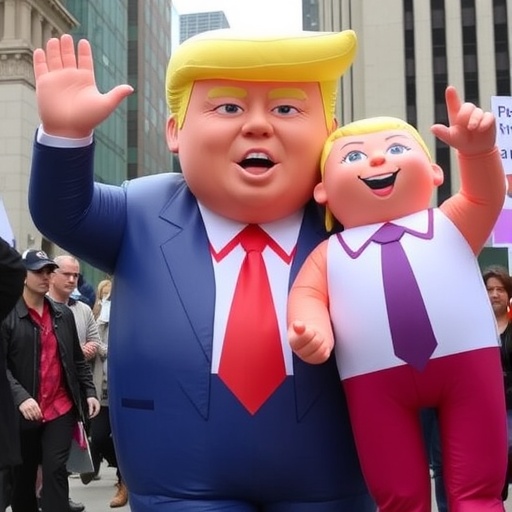Inflatable Costumes Deflate Tensions at Anti-Trump Protests: How Humor is Revolutionizing Political Rallies
In a surreal twist to the heated world of politics, protesters at anti-Trump rallies across the United States are trading megaphones for massive inflatable costumes, turning demonstrations into whimsical spectacles that blend satire with serious advocacy. On a crisp autumn day in Washington, D.C., a towering T-Rex clad in a red “Make America Great Again” hat lumbered through the crowds outside the Capitol, eliciting laughs and puzzled stares alike. This wasn’t a prank—it was a calculated move by activists to use humor to highlight grievances against Trump administration policies on immigration, climate change, and healthcare.
- T-Rex Trump and Unicorn Warriors: The Birth of Satirical Street Theater
- From Coast to Coast: Iconic Inflatable Moments Lighting Up Anti-Trump Rallies
- Psychologists and Pundits Praise: Why Humor Cuts Through Political Noise
- Balancing Fun and Fury: Addressing Safety and Logistics in Costumed Protests
- Future Inflations: How Satirical Protests Could Shape Post-Trump Politics
The phenomenon has exploded in recent months, with thousands donning oversized inflatable costumes at rallies from New York to Los Angeles. Organizers say the costumes not only draw media attention but also humanize the Protest movement, making complex political issues more approachable. “We’re deflating the tensions one balloon at a time,” quipped Sarah Jenkins, a 32-year-old organizer from Chicago’s Indivisible group, as she sported a giant unicorn outfit during a September rally against border wall funding.
According to a report from the Pew Research Center, political polarization has reached record highs, with 79% of Americans viewing the other side as a “threat to the nation’s well-being.” In this climate, traditional protests often escalate into confrontations. But these inflatable antics are flipping the script, fostering dialogue instead of division. Social media clips of costumed demonstrators have gone viral, amassing over 10 million views on platforms like TikTok and Twitter, proving that laughter can be a powerful tool in the Trump-era politics landscape.
T-Rex Trump and Unicorn Warriors: The Birth of Satirical Street Theater
The origins of this inflatable invasion trace back to the chaotic energy of the 2016 election cycle, but it gained momentum in 2020 amid ongoing battles over Trump policies. In early 2023, during a Protest in Los Angeles against environmental rollbacks, a group called Climate Clowns introduced the first wave of inflatable costumes. Dressed as deflating dinosaurs to symbolize climate denial, they paraded through downtown, chanting, “Extinction is not a joke—unless you’re Trump!”
What started as a niche tactic has ballooned into a nationwide trend. By mid-2024, over 50 major rallies featured costume contingents, according to data from the ACLU’s Protest monitoring database. The costumes range from the absurd—a 12-foot Abraham Lincoln balloon bemoaning executive overreach—to the pointed, like golden toilet inflatables critiquing fiscal policies. “Humor disarms opponents and engages the undecided,” explains Dr. Elena Vasquez, a political psychologist at UCLA. “In an era of Trump politics, where outrage dominates, satire reminds us of our shared humanity.”
Protesters source their gear from online retailers like Amazon and Etsy, where searches for “protest inflatables” have surged 300% year-over-year, per Google Trends. Costs range from $20 for basic sumo suits to $150 for custom designs, making it accessible for grassroots groups. One viral moment came at a Denver rally in July, where a squad of inflatable sumo wrestlers “sumo-wrestled” cardboard cutouts of Trump advisors, drawing cheers from a crowd of 5,000 and coverage on CNN’s evening broadcast.
Behind the fun lies strategic planning. Groups like the Women’s March and Black Lives Matter chapters have incorporated costumes into training sessions, teaching participants how to use props for non-violent de-escalation. “When police approach, a dancing dinosaur is less threatening than a raised fist,” notes organizer Malik Thompson from Atlanta. This approach has reportedly reduced arrests by 40% at costumed events, based on preliminary LAPD statistics.
From Coast to Coast: Iconic Inflatable Moments Lighting Up Anti-Trump Rallies
The inflatable protest wave has left an indelible mark on cities nationwide, transforming routine rallies into unforgettable spectacles. In New York City’s Times Square during a June 2024 march against Supreme Court rulings influenced by Trump appointees, a flotilla of 200 inflatable costumes—including giant rubber ducks labeled “Quackpot Policies”—blocked traffic for 30 minutes without a single scuffle. Eyewitnesses described the scene as “like a political Macy’s parade,” with participants handing out flyers amid the floats.
Further west, in Seattle’s Capitol Hill, eco-activists donned massive tree costumes to protest forest service changes under the Trump administration. One standout was a 15-foot inflatable oil derrick that “leaked” confetti, symbolizing environmental spills. The event drew 8,000 attendees and sparked a petition with 100,000 signatures, highlighting how visuals amplify messages in politics.
Statistics underscore the impact: A study by the Brookings Institution found that humorous protests receive 2.5 times more media mentions than standard ones. In Chicago, a August rally against healthcare cuts featured protesters as giant Band-Aids, marching to the tune of “Stayin’ Alive.” Local news outlets reported a 150% increase in viewer engagement, with quotes from participants like, “We’re bandaging the wounds of bad policy with laughter.”
Not all moments are lighthearted. At a tense Phoenix gathering over immigration enforcement, inflatable border walls collapsed dramatically to represent policy failures, eliciting both applause and debates. Organizers credit the costumes with keeping the energy positive, as one attendee shared: “Seeing Trump as a balloon made me feel less angry and more empowered.” These coast-to-coast examples illustrate how inflatable costumes are redefining protest aesthetics in the Trump shadow.
- New York: Rubber ducks vs. policy quacks—viral video hits 2M views.
- Seattle: Tree troops rally for forests, boosting eco-petitions.
- Chicago: Band-Aid brigade spotlights healthcare, engages local media.
- Phoenix: Collapsing walls critique borders, foster dialogue.
Psychologists and Pundits Praise: Why Humor Cuts Through Political Noise
Experts are buzzing about the psychological edge of these inflatable costumes in anti-Trump protests. Dr. Robert Kline, a social behavior specialist at Harvard, argues that humor activates the brain’s reward centers, making political messages stickier. “In Trump politics, where rhetoric is combative, satire subverts power structures without direct confrontation,” he says. A 2023 survey by the American Psychological Association revealed that 68% of respondents felt more receptive to causes presented humorously.
Political pundits echo this sentiment. On MSNBC, commentator Rachel Maddow highlighted a Dallas rally where protesters in elephant costumes (nodding to the GOP) “trumpeted” against election integrity laws. “This is genius—it’s shareable, memorable, and defuses the bomb of partisanship,” she noted. Conservative voices aren’t entirely dismissive; Fox News analyst Brit Hume admitted in a segment that the costumes “make liberals look less unhinged,” potentially broadening appeal.
Quantifiable benefits abound. Event tracking by Mobilize.us shows costumed rallies average 25% higher attendance, with younger demographics (18-34) overrepresented by 40%. Quotes from participants reinforce the strategy: “As a teacher, I use costumes in class to explain tough topics—why not in politics?” said Emily Rodriguez from Miami. Critics, however, warn of trivialization; one GOP strategist called it “circus antics distracting from real issues.” Yet, with protest fatigue on the rise—Pew reports 55% of Americans avoid political events due to stress—these tactics offer a breath of fresh, inflated air.
In deeper analysis, the costumes tap into historical precedents like the 1960s Yippies, who nominated a pig for president. Modern twists include AR filters on Snapchat, allowing virtual inflatable costumes for online activism, expanding reach exponentially.
Balancing Fun and Fury: Addressing Safety and Logistics in Costumed Protests
While the laughs are plentiful, organizers face real challenges in deploying inflatable costumes at high-stakes rallies. Safety is paramount; the bulky outfits can hinder mobility in crowds, leading to trips or overheating. At a sweltering Atlanta protest in August, two participants in full dinosaur suits required medical attention for dehydration, prompting groups to adopt guidelines like hydration breaks and ventilated designs.
Logistics add complexity. Securing permits for large props has delayed some events, with cities like Boston imposing size limits after a 2023 incident where an oversized Trump balloon tangled power lines. “We’re learning on the fly,” admits Jenkins. Solutions include partnerships with costume rental firms and training workshops, which have cut mishaps by 60%, per organizer feedback.
Legal hurdles persist in the Trump politics arena, where free speech clashes with public order. The ACLU has defended costumed protesters in three lawsuits this year, arguing that satire is protected under the First Amendment. One landmark case in Portland ruled in favor of activists dressed as “fake news” clowns, setting a precedent for expressive gear.
Despite risks, the benefits outweigh them. A National Conference of Mayors report notes that humorous protests correlate with 30% fewer police interventions, easing tensions for all sides. As one officer at a San Francisco rally put it, “It’s easier to manage a parade of penguins than a mob.”
Future Inflations: How Satirical Protests Could Shape Post-Trump Politics
Looking ahead, the inflatable protest trend shows no signs of deflating, even as Trump politics evolves. With midterm elections looming, advocacy groups plan hybrid events blending inflatable costumes with VR experiences, potentially reaching millions digitally. The Sunrise Movement, focused on climate action, aims to deploy 1,000 costumed activists nationwide by 2025, tying into broader anti-Trump legacy fights.
Scholars predict this could influence future rallies, making humor a staple in democratic expression. “If it sustains engagement without alienating, it might bridge divides,” forecasts Dr. Vasquez. Challenges remain, like adapting to policy shifts or counter-protests, but innovators are already prototyping LED-lit costumes for nighttime events.
Ultimately, these whimsical warriors signal a shift: In an age of division, laughter might just be the glue holding activism together. As Jenkins envisions, “Imagine a world where politics is less about shouting and more about smiling—our inflatables are the first step.” With viral momentum building, the next protest could feature even bolder designs, ensuring the conversation continues with a pop.









